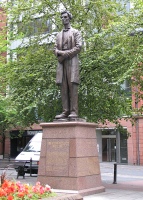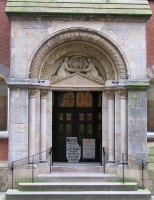 Abraham Lincoln, Lincoln Square, Manchester.
Abraham Lincoln, Lincoln Square, Manchester.
 Abraham Lincoln, Lincoln Square, Manchester.
Abraham Lincoln, Lincoln Square, Manchester.
Lincoln Square lies in the centre of the block faced by Manchester Town Hall, thus bounded by Albert Square, Lloyd Street, Deansgate and John Dalton Street, and is easily walked round entirely without being seen. But within it is a rather large and rather strange statue of Abraham Lincoln, by the American sculptor George Grey Barnard. The Peace Centenary Committee set up to commemorate 100 years of peace between Britain and America in 1914, led by the end of World War I to a proposal for a statue of Lincoln to stand in Parliament Square, London (for pictures of that, see this page), and the statue in mind for the copy to be taken from was that by Saint Gaudens in Chicago. However, an offer by Charles P Taft (the brother of former American President W. H. Taft who had been in office until 1913) of a replica of the Barnard statue was accepted by the American section of the Committee. The copy was made, but felt unsuitable for London, which in the end did get a version of the Saint Gaudens statue. So the Barnard statue was sent to Manchester on the strength of the support of local cotton workers for Lincoln, the Union and the abolition of slavery in the American Civil War.
Originally erected in 1919 in Platt Fields, somewhat to the south of the centre of the city, the statue was moved to the newly-created Lincoln Square in the town centre during the 1980s. Barnard worked on the Cincinnati statue from about 1911, and that original was unveiled in 1917. In the Manchester copy we see a figure of exaggerated thinness, emphasised by the emptily-hanging coat and trousers, the large-seeming head, and the heavy veined hands. The face makes feature of the deep lines and wrinkles, and the chin, which is beardless, while on the neck, which shows little sign of musculature for such a thin figure, there is a prominent Adam’s apple. Apparently Barnard worked from a death mask of Lincoln, so that the work is considered to be a true likeness.
The statue was praised by some at the time, and since, as chiming with the modest nature of Lincoln, and his appeal to the working people who similarly would have leathery skins and hands become oversized by a life of labour. Detractors thought it monstrous and an insult to the memory of the grate statesman. While eschewing the harsh words of the passionate critics of the time, to my mind whatever merits as a portrait and an emblem of the working poor the statue may have, this cannot make up for the lack of greatness and strength of character and nobility of purpose made manifest which are appropriate for a statue of Lincoln. This is not to say that the statue need have shown Lincoln as younger – the Gladstone Memorial in London epitomises how a statue of an older figure can convey a sense of power and gravitas.
Nevertheless, it is interesting to see the Manchester Lincoln, as unusual chance to see work by an early 20th Century American sculpture in Britain. The sculptor, George Grey Barnard, was born in 1863 in Pennsylvania, educated in Chicago and also in Paris under Pierre-Jules Cavalier (the British sculptor Alfred Gilbert had been another pupil of Cavalier), and after exhibiting mainly allegorical figures, in the 1900s came to some prominence back in Pennsylvania for his statues for the Harrisburg Capitol building. He died in 1938.
 Portico of St Mary Mulberry Street, with tympanum.
Portico of St Mary Mulberry Street, with tympanum.
We may note that close to Lincoln Square is St Mary Mulberry Street, with a fine tympanum over the door showing a holy sheep (the lamb of God) in a roundel supported by two angels, and a free-standing statue of the Virgin and Child in a niche on the wall which we need not dwell on, though the supporting corbel to the niche is of some elegance.
Manchester Albert Square // Manchester Cathedral
Sculpture in some towns in England // Sculptors
Visits to this page from 3 May 2013: 7,892